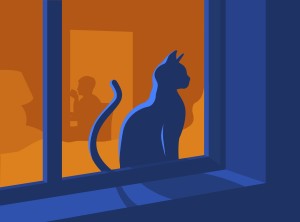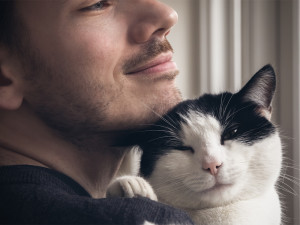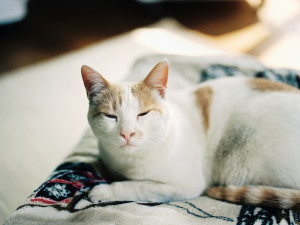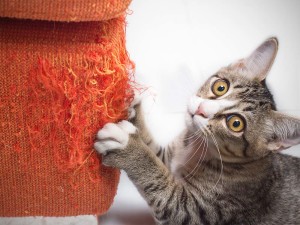Is Orange Cat Behavior Real? The Truth Behind the TikTok Trend
Your TikTok algorithm would like you to think so, but the experts weigh in.
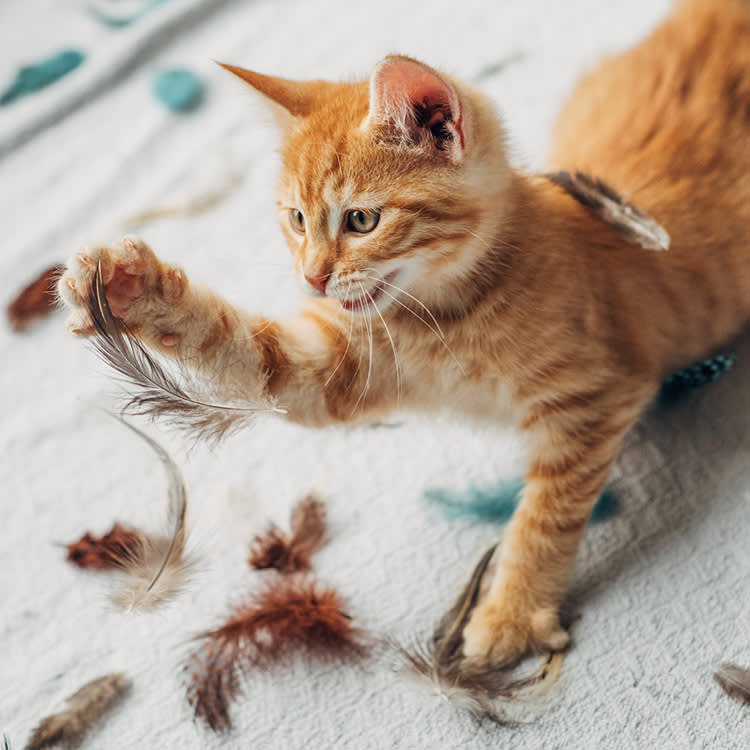
Share Article
In This Article:
What Is Orange Cat Behavior? Orange Cat Genetics Frequently Asked Questions
If you’re a cat lover, you may have noticed your algorithm suddenly going extra hard on orange cat content. Even more specifically: orange cat behavior. And though what exactly that means can be hard to pin down, in general, orange cat behavior is endearing, often derpy, occasionally spicy, and, at times, completely and utterly banal.
But is this accurate? Having both grown up with an orange cat and also recently fostered one, my definition of “orange cat behavior” is distant, stoic, independent, and proud (and maybe even a little ferocious). My mother’s cat was aloof, and my foster cat once ripped a six-inch gash into my wrist when I tried to pick him up.
But, given that these cats were both feral before they came into my life, attributing their behavior to their orange-ness feels like a stretch. After all, causation and correlation are not the same thing. While I might prefer the story that their shared hostility towards me was caused by the color of their fur, that doesn’t make it true. Is “orange cat behavior” real or not?
What is orange cat behavior?
Orange cat parents often believe their fiery-colored felines have personalities that match their vibrant coats. And there’s been no shortage of iconic orange tabbies in pop culture, from the lazy Garfield to Ridley’s Jonesy in the Alien movies.

The trend of “orange cat behavior” has taken off on TikTokopens in new tab and other social media platforms in the last few years, especially when these cats do something endearingly goofy — like climbing to a place in the house where they can’t get down or awkwardly posing on furniture. Orange cat behavior, in these instances, is seen as silly, chaotic, friendly, or all of the above, suggesting that these felines are just a little more… everything! Truly a horse (or rather, a cat) of a different color.
Do orange cats have a distinct personality?
Orange cats’ bright coats often lead people to ascribe similarly bright personalities to orange cats, casting them as more affectionate and outgoing, or just more prone to adventurous — or, let’s face it, silly — mistakes. Some people think orange cats are more prone to cases of the zoomies, risky behaviors, and general tomfoolery.
“There are several studies using client surveys that suggest that there may be perceived differences in behavior associated with color,” veterinary behaviorist Dr. Valli Parthasarathy of Synergy Veterinary Behavioropens in new tab says. “However, there have not been patterns that, in my opinion, are consistent enough to make general statements about color effects on behavior.”
Why do orange cats act weird?
When it gets down to it, they don’t. While the “orange cat behavior” trend online might portray them as endearing oddballs, there’s no evidence that orange cats are any stranger than other cats.
To date, no studies have shown any impact of coat color on personality in cats,” veterinary behaviorist Dr. Mikel Delgadoopens in new tab tells Kinship. “There are survey-based studies that demonstrate that humans might think there are differences in cat behavior or personality based on coat color; however, no studies to date have found a relationship between coat color and behavior by actually testing cats.”
The one study she is aware of found no differences in behavior (shyness, activity, friendliness to a new person, etc.) between cats with orange coats and other coat colors.
Are orange cats friendly?
It’s tempting to link a cat’s color to their personality, but science says there is no such thing as orange cat behavior. While numerous studies out there draw links between cat breeds and certain personality traits, analysis of these studies has found their conclusions are often flimsy at best, relying as they do on small data sets or people’s reported observations of their own cats’ behaviors.
The problem with this kind of survey-based research is that every human participant will perceive traits like friendliness, aggression, or shyness differently. Those same people are also more likely to note and report the traits that already fit the narrative they have for their cats and disregard or downplay the ones that don’t.
“If anything, [the orange cat behavior phenomenon] is a great example of how good people are at finding patterns where they don’t actually exist,” cat behaviorist Kristiina Wilsonopens in new tab tells Kinship. “They hear or decide that orange cats act a certain way, and when they do, the person makes note of it. But all the times they don’t act that way, their brains don’t really file the information away.”
Are orange cats more aggressive?
It is also worth noting that approximately 80 percent of orange cats are male, and it’s possible that male cats can have more rambunctious temperaments. But this also could be related to how we perceive male cats versus female; for instance, the term “tortitude” refers to calico cats, who tend to be female. While orange cats, who are usually male, are often characterized as silly and lovable, tortoiseshell cats are often framed as being sort of standoffish.
“I think there is a sort of sexism from the jump about the way we perceive these animals,” Wilson says. This is not to say that the people participating in the proliferation of these terms online are being sexist or that calico parents adore their cats any less than orange cat parents do. But it is always worth examining the ways our understanding of the world around us might be influenced by biases, whether we are conscious of them or not.
Orange cat genetics
A variety of factors can impact cat behavior — from their surroundings, to their genes, to even the food they eat. Behavior is not a result of any single aspect of a cat’s life (and certainly not their coat color), but instead a combination of factors contribute to cat behavior. And genetics play a role, too.
“Genetics and experience both [impact] a cat’s behavior,” Dr. Valli says. “Many of their species-typical behaviors (such as scratching on furniture, crepuscular activity patterns, patterns of play) have strong genetic components. How they react to threats can also have genetic influences. However, they also learn what works for them in a particular living environment and can adjust their behavior accordingly.”
Common orange cat breeds
Orange cats are not particular to any one breed, and so this coloring can occur across a wide variety of breeds, including Persians or American Bobtails. Behavior-wise, a cat’s breed may be a better indicator of personality than coat color, according to some studies.
Just like humans, genetics can play a role in a cat’s temperament and personality. However, it’s important to keep in mind that while a cat’s breed can give you a general idea of their traits, it’s not a guarantee of any specific characteristics.
Are orange cats always male?
Orange cats aren’t always male — but the majority of them are. Approximately 80 percent of orange cats are male. “This is because the gene for orange fur is sex-linked and only on the X chromosome,” Dr. Delgado explains. “Females have two X chromosomes (XX), while males only have one (XY).”
This means males only need to inherit the orange fur gene from one parent in order to be full orange, while females need to inherit it from both; otherwise, they will be born calico or tortoiseshell. And while orange cats are overwhelmingly male, calico and tortoiseshell cats are, according to research, overwhelmingly female.
Are orange female cats rare?
Orange female cats are certainly more rare than male orange cats. Because the orange fur gene is sex-linked and only on the X chromosome, this means that female orange cats have inherited the gene from both parents, rather than just one.
What percentage of orange cats are female?
Approximately 20 percent of all orange cats are female.
Bottom line
In the end, every cat has their own personality, regardless of the color of their fur or any other defining physical features. While some traits may be more common in some breeds, this variance doesn’t apply to coat colors.
All this is to say that the way we perceive our cats (not to mention the rest of the world) often says more about us than it does about them. And the fact is that all cats, under the right circumstances, can be derpy or sly, standoffish or snuggly, no matter their color, sex, or breed.
FAQs
Do orange cats behave differently?
Because orange tabby is not a breed, it’s difficult to make any generalizations about the personalities and temperaments of orange cats. There is no evidence that they behave any differently than cats of other colors.
Why are orange cats more feisty?
The majority of orange cats are male, so it could just be that male cats have more rambunctious temperaments. Regardless, it’s important to accept your cat as they are and not expect specific behaviors from them.
Are all orange cats male?
Orange cats are more likely to be male than female, but there are female orange cats as well.
Do orange cats have health problems?
Some cat breeds are more prone to health issues than others, but coat color has no impact on a cat’s risk level for any health concern.
References
Delgado, Mikel M., et al. “Human Perceptions of Coat Color as an Indicator of Domestic Cat Personality.” Anthrozoӧs, vol. 25, no. 4, Oct. 2012, pp. 427-40. https://doi.org/10.2752/175303712x13479798785779opens in new tab.
Don’t Be so Fast to Judge a Cat by Its Color, Study Warns } Research UC Berkeley. vc.research.berkeley.edu/news/dont-be-so-fast-judge-cat-its-color-study-warnsopens in new tab.
Kalantry Lab - Calico Cat. kalantry.lab.medicine.umich.edu/research/calico-catopens in new tab. Accessed 12 Dec. 2024.
Mikkola, Salla, et al. “Reliability and Validity of Seven Feline Behavior and Personality Traits.” Animals, vol. 11, no. 7, July 2021, p. 1991. https://doi.org/10.3390/ani11071991opens in new tab.
Morgan, Rebecca Sandford. Personality in Domestic Cats (Felis Catus): Identification and Description of Personality Structure, Predictive Validity, and Associations With Coat Color Characteristics - ProQuest. www.proquest.com/openview/c1e83fc7a4863d977d4da5cc11cd3ef7/1?pq-origsite=gscholar&cbl=18750opens in new tab.
Wilhelmy, Jacqueline, et al. “Behavioral Associations with Breed, Coat Type, and Eye Color in Single-Breed Cats.” Journal of Veterinary Behavior, vol. 13, May 2016, pp. 80-87, https://doi.org/10.1016/j.jveb.2016.03.009opens in new tab.

Charles Manning
Charles Manning is an actor and writer based in New York City. In his free time he likes to cook, go swimming at the public pool, volunteer at the LGBTQ senior center, and foster senior and special-needs cats. His work has previously appeared in Cosmopolitan, Elle, Marie Claire, Harper’s Bazaar, Seventeen, and Nylon.

Savannah Admire
Savannah Admire is a writer and pet mom to two dogs and a cat. Under the name Savannah Cooper, she has published poetry in 40 different publications, as well as a poetry book, Mother Viper (2025). When she’s not writing, you can find her reading, taking photos, or volunteering as a content creator for her local community theatre. As a pets writer, she focuses on cat and dog behavior and pet parenthood. She currently lives in Western Maryland.
Related articles
![cat snuggling man]()
What’s Your Cat’s Love Language?
Five surprising ways cats show affection (and how you can show it back), according to a cat behaviorist.
![]()
This Study Says You Literally Can’t Hide From Your Cat
Happy spooky season.
![White and light brown cat laying down with eyes almost closed]()
Study Says “Slow Blinking” at Your Cat Helps You Bond
A team of psychologists at the Universities of Sussex and Portsmouth have discovered the key to building a bond with cats.
![Kitten scratching fabric sofa]()
How to Stop Your Cat From Absolutely Ripping Apart Your Couch
Placing a cat tree or post in a room only, uh, scratches the surface of solving this problem.
![Training a cat sitting with leash and harness on.]()
A Step by Step Guide on How to Clicker Train Your Cat
This popular training technique isn’t just for dogs. Here’s how you can use it for your cat.
![An angry and hissing Siamese kitten standing on top of a laptop computer in the living room]()
You Don’t Have to Live Like This—You Can Get a Trainer For Your Cat
Tips to help you find a legit behaviorist (according to a veterinary behaviorist).

